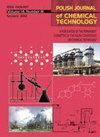Synthesis and spectroscopic interpretations of Co(II), Ni(II) and Cu(II) decxycholate complexes with molecular docking of COVId-19 protease
IF 1
4区 工程技术
Q4 CHEMISTRY, APPLIED
引用次数: 2
Abstract
Abstract Co(II), Ni(II) and Cu(II) decxycholate complexes are interesting due to their biologically active and deliberate interest in the research due to their coordination properties. The microanalytical ‘elemental analysis’, molar conductivity, (infrared and Raman) spectroscopy, thermal analyses (TGA/DSC), UV-vis spectra, and ESR for copper(II) decxycholate complex investigations were performed in the structural assignments of Co(II), Ni(II) and Cu(II) decxycholate complexes. Reaction of the sodium deoxycholate ligand (C24H39O4Na) with three transition metal ions form the complexes of formulae, [M(C24H39O4)2(H2O)2]. xH2O where M = Co(II), Ni(II) and Cu(II) where x = 2 for Cu(II) and x = 4 in case of M = Co(II) or Ni(II) metal ions. The FTIR spectra of the complexes show that decxycholate molecule is present as bidentate ligand. Molecular docking utilizing to additionally examine the interaction of COVID-19 (6LU7) with different complexes of deoxycholic acid with Co(II), Ni(II) and Cu(II). Furthermore, in the case of Co(II) deoxycholate complex, the probe is surrounded by amino residues Met235, Pro241, Glu240, Pro108, Gln110, Phe294, and Ile152. The probe molecule of Ni(II) deoxycholate complex is sited close to amino acids Tyr126, Tyr239, Leu287, Leu272, and Lys137. For, Cu(II) deoxycholate complex, the residues of amino acids comprise of Pro132, Pro108, Gln110, Gly109, Ile200, Asn203, Val202, His246, Pro293 and Tyr154. The binding energy was determined from the docking reads for Co(II)–6LU7, Ni(II)–6LU7 and Cu(II)–6LU7 deoxycholate compounds were found to be −446.99, −500.52, −398.13 kcal mol−1 individually.与COVId-19蛋白酶分子对接的Co(II)、Ni(II)和Cu(II)脱羧胆酸配合物的合成和光谱解释
Co(II)、Ni(II)和Cu(II)脱羧胆酸盐配合物因其生物活性和配位特性而备受关注。在Co(II)、Ni(II)和Cu(II)脱羧胆酸配合物的结构分配中,对铜(II)脱羧胆酸配合物进行了微量分析、摩尔电导率、(红外和拉曼)光谱、热分析(TGA/DSC)、紫外可见光谱和ESR研究。脱氧胆酸钠配体(C24H39O4Na)与三个过渡金属离子反应形成式[M(C24H39O4)2(H2O)2]的配合物。xH2O,其中M = Co(II), Ni(II)和Cu(II),其中对于Cu(II) x = 2,对于M = Co(II)或Ni(II)金属离子x = 4。配合物的红外光谱表明,脱羧胆酸盐分子以双齿配体的形式存在。利用分子对接进一步研究COVID-19 (6LU7)与不同脱氧胆酸与Co(II)、Ni(II)和Cu(II)配合物的相互作用。此外,在Co(II)脱氧胆酸盐配合物的情况下,探针被氨基残基Met235, Pro241, Glu240, Pro108, Gln110, Phe294和Ile152包围。Ni(II)脱氧胆酸盐配合物的探针分子位于Tyr126、Tyr239、Leu287、Leu272和Lys137氨基酸附近。对于Cu(II)脱氧胆酸配合物,氨基酸残基包括Pro132、Pro108、Gln110、Gly109、Ile200、Asn203、Val202、His246、Pro293和Tyr154。Co(II) -6LU7、Ni(II) -6LU7和Cu(II) -6LU7脱氧胆酸化合物的对接能分别为- 446.99、- 500.52和- 398.13 kcal mol - 1。
本文章由计算机程序翻译,如有差异,请以英文原文为准。
求助全文
约1分钟内获得全文
求助全文
来源期刊

Polish Journal of Chemical Technology
CHEMISTRY, APPLIED-ENGINEERING, CHEMICAL
CiteScore
1.70
自引率
10.00%
发文量
22
审稿时长
4.5 months
期刊介绍:
Polish Journal of Chemical Technology is a peer-reviewed, international journal devoted to fundamental and applied chemistry, as well as chemical engineering and biotechnology research. It has a very broad scope but favors interdisciplinary research that bring chemical technology together with other disciplines. All authors receive very fast and comprehensive peer-review. Additionally, every published article is promoted to researchers working in the same field.
 求助内容:
求助内容: 应助结果提醒方式:
应助结果提醒方式:


